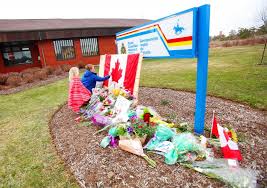Canada Mourns 23, killed in Mass Shooting

OTTAWA — Canadians began to mourn the victims as much of the country is locked down because of the coronavirus pandemic. So they will need to mourn at a safe distance: Prime Minister Justin Trudeau said on Monday a virtual vigil will be held on Friday. The massacre began late Saturday night in Portapique, a village of about 100 residents on the Bay of Fundy. It ended more than 13 hours later at a gas station in Enfield, 55 miles away, with the gunman shot dead by the police and his victims’ bodies strewn across 16 crime scenes in a more than 30-mile area.
One was a 23-year veteran police officer, and mother of two young children, responding to a call about a shooting. Another had just survived her second bout of brain cancer. A third was out for a walk.All three were victims in Canada’s worst mass shooting, which killed at least 22 people, including a teenager, in a 12-hour rampage over the weekend in a scenic vacation area of Nova Scotia.
Much about the killings remains unknown, including the motive of the gunman. The police were still sorting through the crime scenes and the burned-out wreckage of the five buildings and cars set ablaze during the attacks. An official list of the dead has yet to be released while Nova Scotia’s now overwhelmed coroner’s service deals with identifying the victims. On Tuesday, the police said one of those killed was a 17-year-old, but gave no additional information.
But since Sunday several names have emerged through eulogies by family and friends on social media or, in some cases, through news releases from employers and unions. The only victim identified by the Royal Canadian Mounted Police to date is one of their own: Constable Heidi Stevenson. During her 23 years with the force, she had been a member of its ceremonial musical ride, one of the vestiges of the days when its officers traveled the country on horseback.
Cole Harbour District High School in Halifax, Nova Scotia’s largest city, had been buffeted by race-related brawls. Ms. Riley-Oettl said Ms. Stevenson became an effective mediator, a mentor for young women and the coach of her rugby team. She took the time to get to know the students and became such a part of the school community that she married the gym teacher. “She became a mentor and older sister for a lot of students and members of the rugby team,” said Ms. Riley-Oettl, who is now a lawyer in Toronto. “It was an inspiration for us girls to see a strong woman who was a police officer and a former rugby player.”
Lillian Hyslop, another victim of the shootings, had moved to Wentworth Valley, an area of Nova Scotia with a small ski resort, after the retirement of her husband, Mike. They had left the northern chill of the Yukon Territory for the comparatively balmy maritime climate of southern Nova Scotia. She was taking a walk when her neighbors were calling each other to relay police warnings to stay inside and take cover because of the shootings.
With victims not yet officially identified, some families remain uncertain about what happened to their loved ones, with some told only that they are missing and others told nothing. Justin Zahl said he is now in limbo, uncertain about his parents’ fate. His mother and father, Elizabeth Joanne Thomas and John Zahl, lived next door to the killer’s summer home in Portapique, a close-knit beachside village, where the police said the rampage began.
But he last heard from his mother on Saturday at 11:30 p.m. The following evening, the police called to say his parents were missing but he said they didn’t mention that their house had burned down. He discovered that on Monday after spotting a photograph of the house on Facebook. “I have lost all faith in the system. I am in shock, this is scary and extremely frustrating,” Mr. Zahl said. “My parents are angels, they are good people, I want to know what happened.”
But others have confirmed the worst, including the friends and family of Jolene Oliver, Aaron Tuck and their daughter Emily, who had been together at home in Portapique when they were killed. Ms. Oliver’s sister, Tammy Oliver-McCurdie, wrote on Facebook that organizing a funeral during the coronavirus outbreak that would give these three victims the commemoration they deserved was difficult.
With the country still in shock, Mr. Trudeau said on Tuesday that his government will move forward with a promise he made during last year’s federal election to ban what he described as military-style assault rifles. The campaign promise also included a buy-back program for such weapons. “I can say that we were on the verge of introducing legislation to ban assault-style weapons across this country — it was interrupted when the pandemic caused Parliament to be suspended,” Mr. Trudeau told reporters. Police have not disclosed what type of guns were used by the shooter in Nova Scotia.
With Canada trying to slow the spread of the coronavirus, the survivors are now left to find a socially distanced way to grieve. The details of Friday’s virtual vigil, being arranged by the local community, are still being worked out. Coming closer than two meters, or 6.5 feet, to another person, let alone hugging, is banned in Nova Scotia. The number of coronavirus cases in the province has reached 720, and only a maximum of five people may attend funerals.
People across Canada placed lit candles in their windows for the victims on Monday night, and shared tributes and condolences online. Flight tracking images of a plane forming a heart above the affected communities on Sunday night have gone viral. A Facebook page set up to support the communities affected by the shootings has gained more than 40,000 members. It is flooded with videos of people playing guitar, bagpipes and fiddle — mainstays of traditional Nova Scotian music.
“It is going to be tough. There’s no doubt about it,” said Dr. Theresa Tam, Canada’s chief public health officer, about the process of mourning at a safe distance. “But I think people will find a way and I think people in Nova Scotia will, in their own way, be able to mourn together.”





